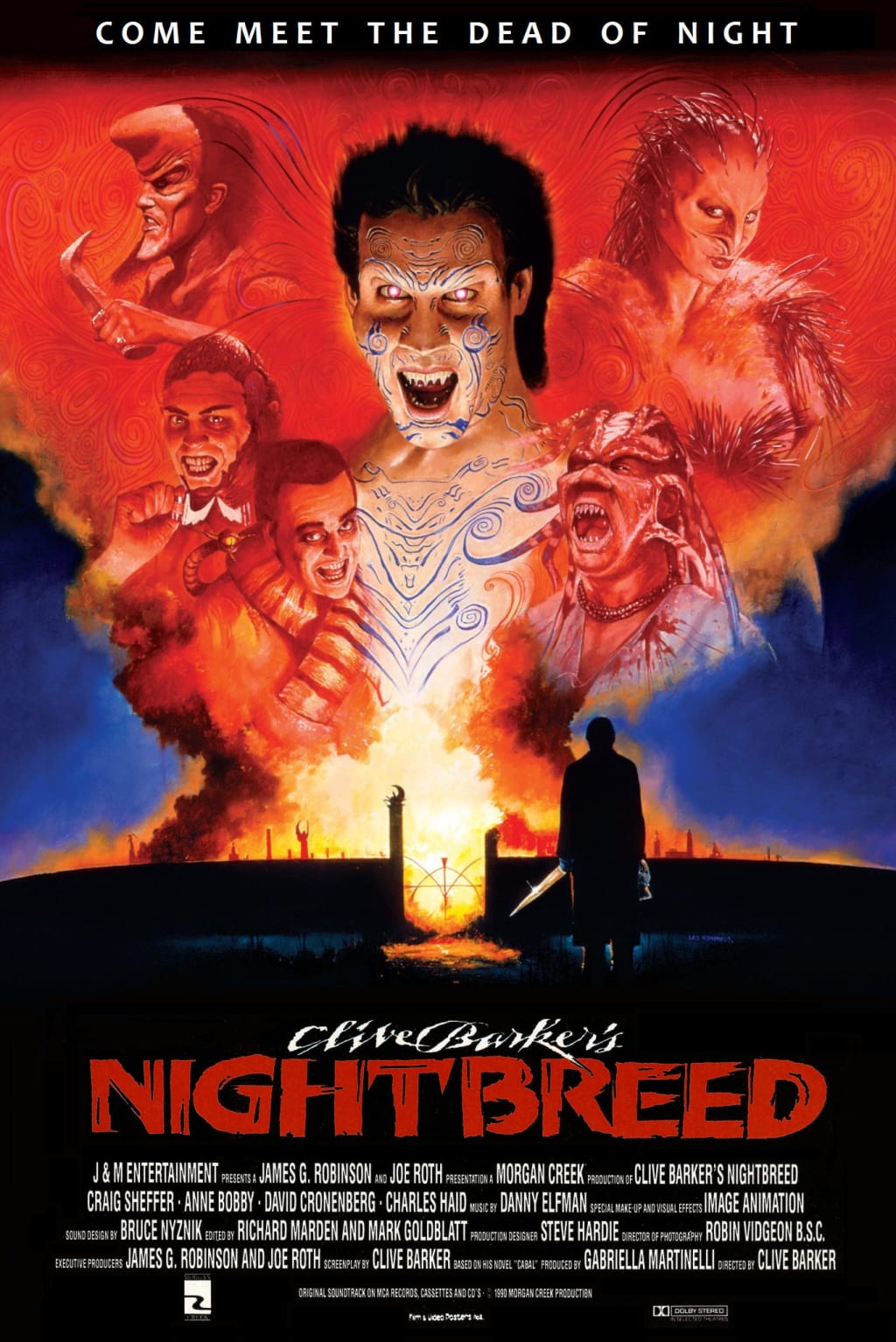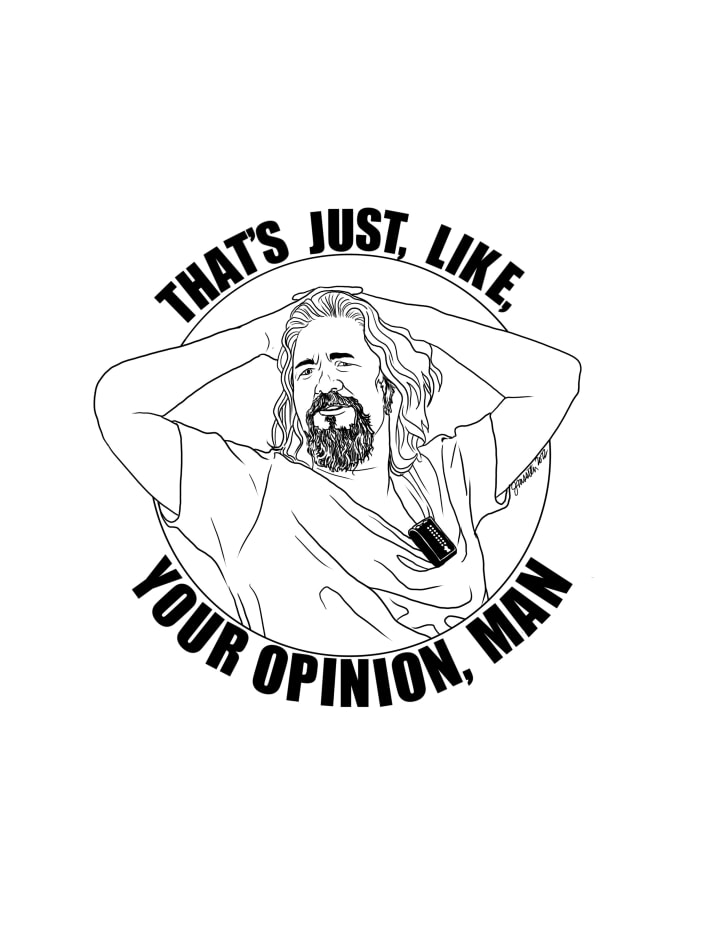Horror in the 90s: 'Nightbreed'
Another hidden gem of 90s horror, I'm happy to have discovered Nightbreed for myself.

Nightbreed (1990)
Directed by Clive Barker
Written by Clive Barker
Starring Craig Scheffer, David Cronenberg, Anne Bobby
Release Date February 16th, 1990
Box Office Gross $16 million dollars
Clive Barker wastes no time; you see his monsters, his Nightbreed, before the credits roll in Nightbreed. In terms of visual storytelling, a wall of cave paintings tells us that the monsters here are ancient, perhaps a pre-cursor to, or a compatriot of, early man. If these cave paintings are telling a story, that's unclear. Holy crap! Again, we waste no time. A mess of monsters are racing about to a classically Danny Elfman score, because this is a Danny Elfman score, his most underrated and forgotten. The scene is very... Andrew Lloyd Webber. The monsters and the choreography of these monsters running about in a graveyard is, at the very least, Broadway inspired.
This is a dream sequence which explains the highly theatrical production and the stage-setting for the action. Our lead character, Aaron Boone (Craig Scheffer) has awakened from a dream of these fantastical monsters which we will learn are part of a long running delusion that has plagued Aaron for years. In this scene, we are struck by the way in which writer-director Clive Barker self-inserts into this story. Having his handsome main character dreaming up these fantastical monsters is a very obvious corollary to the writer-director-author who has, in fact, dreamt up these monsters for this movie, and before that, his book, Cabal, the inspiration for Nightbreed.
In rushed exposition we find that Aaron has been recovering for years from the belief that his dreams of fantastical monsters were real. These dreams landed him in the care of Dr. Phillip K. Decker (David Cronenberg), an imperious and imposing figure who seems to know immediately that Aaron is dreaming of those monsters again as, out of the blue, he calls Aaron to come to his office for an emergency session. This is also driven by the resurgence of a masked serial killer who has returned just as Aaron's dreams have returned. Dr. Decker suspects that Aaron may be this killer and if his dreams are back, that may be what drives the killing.
Speaking of that masked serial killer, a sequence of terror soon unfolds without warning, a slasher horror scene that is among the best of the decade. Here, Clive Barker takes us into a random suburban home. A loving wife and her husband are laughing together and playful, it's sweet. They have a young son and he gives us the first sign of something unseemly occurring. The boy tells his mother that he's afraid and claims that he was kept awake by a 'bad man.' This bad man turns out to be the real deal, a slasher killer who makes an incredible first impression.
Employing a horror filmmaking trope, Barker has the mother enter the family kitchen, pristine, homey and white. The mother approaches the refridgerator and opens the upper door. This serves to block a portion of empty space next to her. Naturally, the trained film watcher knows that when mom closes the freezer door, someone, or some thing, will be there and this scene will move jarringly from the suburban mundane to the terrifying. Here, since he's employing a familiar trope, Barker has to deliver something big. Something shocking. And boy does he deliver.
A killer wearing one of the most terrifying masks we will see in 90s horror, is behind that freezer door. He immediately slashes mom to death with what is surely an incredibly sharp blade. The movement is swift and horrifying and your breath catches when you see the blood spray across that formerly cozy kitchen. The visual of the blood on the ground, spreading across the white tile, and the sight of apples that the mother was near or carrying covered in blood as the roll across the floor is a sublime horror visual. The gurgling of the mother character as she crawls desperately from the kitchen to the hallway, unable to call for help due to the wound in her throat, is haunting and horrific.
Dad is next. The killer, wearing this incredibly scary mask and a long black trench coat, a look that evokes a much more frightening take on Claude Rains' The Invisible Man, enters the living room and shuts off the lights. In just a brief moment that superbly heightens the awfulness of what is to come, dad smiles to himself, assuming that his lovely wife has returned for more intimacy. He's wrong, of course, and that we know it and he doesn't adds another layer of deep dismay. Once dad is dead, the scene heightens again.
Our mind flashes to that little boy at the top of the stairs. Knowing this, and taking remarkable advantage of our empathetic rooting interest, Barker chooses to move the camera to the child's perspective, looking down the stairs at the killer. Here, Barker masterfully pauses, giving us the brief hope that maybe the killer won't look for the boy, maybe the child will merely be a witnes to this terror. That hope is snuffed out as the killer's sickening gaze, through what looks like buttons where his eyes should be. The mask evokes another, much less well-known influence, 1976's The Town That Dreaded Sundown, a Charles B. Pierce directed film, and also a movie about a serial murderer in a mask.
Does the child die? We don't know, we never find out. The scene closes in the child's perspective as the killer slowly, menacingly ascends the stairs. I can't stress how great this scene is. In only his second feature film, following the less than stellar but entirely memorable, Hellraiser, Clive Barker demonstrates masterful control over his camera, the patience of Hitchcock in letting his scene build while adding details to amp the moment, and an ingenious notion of how to end a scene thick with dread and intrigue. It's remarkable and I am shocked I've not heard about this scene before.
Another example of Barker's growth as a director is his choice to follow this scene by letting off some steam. He needs to place his characters on a map for the story to proceed. Thus, Aaron is at work and his girlfriend, Lori (Anne Bobbi), drops in for a visit. She explains that she's going to be at a nightclub that night, performing as a singer. The dialogue is all exposition but it's not tedious as Aaron and Lori are making out almost the whole time, breaking for dialogue and an occasional breath. Scheffer and Bobbi have tremendous sexual chemistry so the making out is a good choice but we now also know where the characters are going to be and why. What looks like a superfluous scene then, is thus now a scene that has set the table for what is to come and established the couple even further as young lovers we want to see together again.
Great directors know that you need to make each scene count and this one counts. Following the breathtaking intensity of that murder scene, the makeout/exposition scene is a needed breather for the audience. We need to know where Aaron is and where he's going. We know that he's not the killer but he is blissfully unaware of what is happening and how it will soon lead to his untimely death and bizarre return in a frightening yet familiar afterlife. Oh, yeah, Aaron dies not long after this tension breaking scene. Murdered by Police and at the behest of Dr. Decker, the real killer, who uses Aaron as a scapegoat and his gateway to locating the nightbreed. Decker is representative of a political view that opposes the existence of this outsider group, this Nightbreed. He plans to use Aaron to find them and wipe them out.
Aaron's death marries the serial killer plot and the monster plot. Even before he died, Aaron had searched for the graveyard home of the nightbreed, it's always called out to him. Now that he's dead, he's one of the nightbreed and more easily is able to enter their graveyard home. He's even welcomed when he arrives. What he and the rest of the Nightbreed don't know is that Dr. Decker knows where Aaron's now zombie form has gone and is on his tale with corrupt Police in tow. They aim to destroy the Nightbreed leading Aaron, now known as Cabal, to rally the ragtag monsters to defend themselves.
Leather jacket, white t-shirt, and jeans, the costume choice for our main character is intentionally a reference back to the hoodlum heroes of the 1950s, but why? Why evoke Brando and his many, many imitators here? Why evoke the 50s at all? My theory is that this was the uniform of the disruptor of the time, that outlaw figure whom Barker would possibly have grown up admiring. Taking that idea a step further, horror is about disrupting the status quo and the hoods of the 1950s are symbolic of that idea, societal outcasts, living outside the law, outside the demands of polite society. Boone is our hero after all, so why not have him in the costume of the hero that Barker and so many others idolized from that long gone era.
Nightbreed is rich with that kind of detail, details that never distract but rather enhance scenes. It's a little thing but the best directors take care to use the tools at their disposal to enrich their movies and Barker shows himself, in Nightbreed, to be quite a good director, a detailed and thoughtful director. He uses uses subtext incredibly well, not just in this costume choice, but as an overarching element of Nightbreed and an incredibly important aspect of the movie.
Though he wasn't widely known as a gay man at the time Nightbreed was released, Clive Barker was not afraid to have his real life act as subtext in his film. Nightbreed is about outsiders being attacked simply for existing and being different. The corollary is rather obvious and Barker underplays it. The character of Aaron/Cabal is explicitly, almost comically, portrayed as heterosexual. It borders on a parody of insecure men desperate to prove their masculinity. But a more relatable corollary is, perhaps, the ally, a person secure enough in their own identity that they can relate comfortably and eagerly with the othered, outsider community. Aaron/Cabal becomes a defender of the Nightbreed, someone who can more easily live in both worlds because of his identity. Aaron is an ideal ally in that sense.
The political subtexts are clear but only if you are looking for them. In the early 90s, and throughout history, the Gay Community was framed as a problem for society at large. Thus, a group of outsiders, peacefully going about their lives before becoming the subject of someone else's political agenda is a strong way to sub textually align the gay community with Barker's supposed 'monsters.' It's a powerful subtext and its incredibly well layered into the story of Nightbreed.
Nightbreed is equally entertaining and exciting as an allegory and as a monster movie. Clive Barker's deft direction does settle into familiar areas once we get past that incredible murder scene I mentioned earlier, but it's still quite a good monster movie. If you want to parse the subtext you can, and I feel that doing so deepens the experience of Nightbreed. That said, if you just want creepy monsters and creepier human monsters, Nightbreed is strong enough as just a monster movie to satisfy.
This review of Nightbreed is part of my new book project unofficially called Horror in the 90s. It's a book that will feature reviews of, hopefully, all theatrically released horror movies of the 1990s. It will be more than just reviews, the book will feature articles on the writers, directors, and stars who made the best and worst of the horror genre of the 1990s. It's an ambitious project and it's a project I cannot complete without your support.

You can help me bring this book into reality by making a monthly pledge or by leaving a one-time tip. Vocal allows for you to support this project on this very platform. Anyone who makes a pledge or a tip will receive a thank you mention in the book once it is completed. If you'd like to follow the progress of the book, I am publishing pieces of the book here on Vocal via Horror.Media. I've already published articles and reviews of Henry Portrait of a Serial Killer, The First Power, Brain Dead, Tales from the Darkside The Movie, The Exorcist 3 and Frankenhooker.
About the Creator
Sean Patrick
Hello, my name is Sean Patrick He/Him, and I am a film critic and podcast host for the I Hate Critics Movie Review Podcast I am a voting member of the Critics Choice Association, the group behind the annual Critics Choice Awards.






Comments
There are no comments for this story
Be the first to respond and start the conversation.